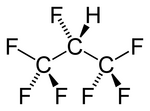1,1,1,2,3,3,3-Heptafluoropropane
 |
|
 |
|
| Names | |
|---|---|
|
Preferred IUPAC name
1,1,1,2,3,3,3-Heptafluoropropane
|
|
| Other names
Heptafluoropropane
Apaflurane HFC-227ea R-227ea HFC-227 |
|
| Identifiers | |
|
431-89-0 |
|
| 3D model (Jmol) | Interactive image |
| ChEMBL |
ChEMBL2104472 |
| ChemSpider |
61257 |
| ECHA InfoCard | 100.006.437 |
| PubChem | 67940 |
| UNII |
R40P36GDK6 |
| UN number | UN3296 |
|
|
|
|
| Properties | |
| C3HF7 | |
| Molar mass | 170.03 g/mol |
| Density | 1.46 g/cm3 at -16 °C |
| Melting point | −131 °C (−204 °F; 142 K) |
| Boiling point | −16.4 °C (2.5 °F; 256.8 K) |
| Hazards | |
| NFPA 704 | |
| Related compounds | |
|
Related compounds
|
1,1,1,2,2,3,3-Heptachloropropane |
|
Except where otherwise noted, data are given for materials in their standard state (at 25 °C [77 °F], 100 kPa).
|
|
|
|
|
| Infobox references | |
1,1,1,2,3,3,3-Heptafluoropropane, also called heptafluoropropane, HFC-227 or HFC-227ea (ISO name), as well as apaflurane (INN), is a colourless, odourless gaseous halocarbon commonly used as a gaseous fire suppression agent.
Its chemical formula is CF3-CHF-CF3, or C3HF7. With a boiling point of −16.4 °C, it is a gas at room temperature. It is slightly soluble in water (260 mg/L).
HFC-227ea finds use in fire suppression systems in data processing and telecommunication facilities, and in protection of many flammable liquids and gases. HFC-227ea falls in the category of Clean Agents and is governed by NFPA 2001 - Standard for Clean Agent Fire Extinguishing Systems. Effective fire suppression requires introducing a concentration of the HFC-227ea agent between 6.25% and 9% depending on the hazard being protected. Its NOAEL level for cardiac sensitization is 9%. The United States Environmental Protection Agency allows concentration of 9% volume in occupied spaces without mandated egress time, or up to 10.5% for a limited time. Most fire suppression systems are designed to provide concentration of 6.25-9%.
The HFC-227ea fire suppression agent was the first non-ozone depleting replacement for Halon 1301. In addition, HFC-227ea leaves no residue on valuable equipment after discharge.
HFC-227ea contains no chlorine or bromine atoms, presenting no ozone depletion effect. Its atmospheric lifetime is approximated between 31 and 42 years. It leaves no residue or oily deposits and can be removed by ventilation of the affected space.
As an aerosol propellant, HFC-227ea is used in pharmaceutical metered dose inhalers such as those used for dispensing asthma medication.
...
Wikipedia

